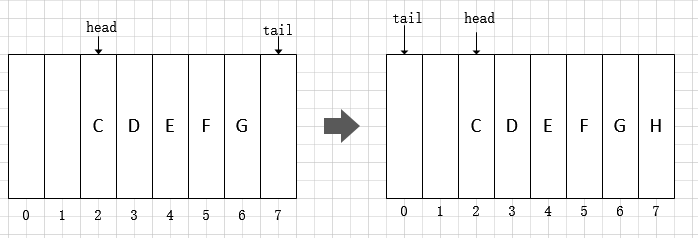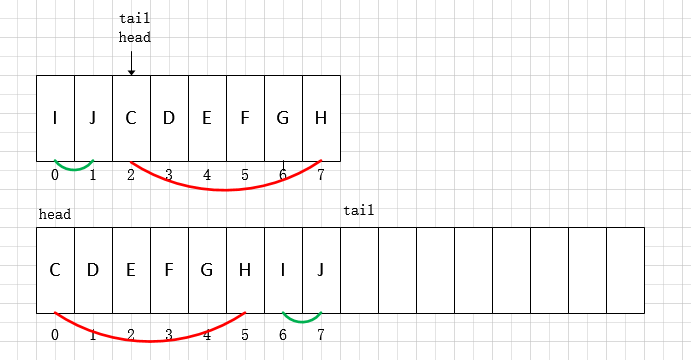Java 容器源码分析之 Deque 与 ArrayDeque
Queue 也是 Java 集合框架中定义的一种接口,直接继承自 Collection 接口。除了基本的 Collection 接口规定测操作外,Queue 接口还定义一组针对队列的特殊操作。通常来说,Queue 是按照先进先出(FIFO)的方式来管理其中的元素的,但是优先队列是一个例外。
Deque 接口继承自 Queue接口,但 Deque 支持同时从两端添加或移除元素,因此又被成为双端队列。鉴于此,Deque 接口的实现可以被当作 FIFO队列使用,也可以当作LIFO队列(栈)来使用。官方也是推荐使用 Deque 的实现来替代 Stack。
ArrayDeque 是 Deque 接口的一种具体实现,是依赖于可变数组来实现的。ArrayDeque 没有容量限制,可根据需求自动进行扩容。ArrayDeque不支持值为 null 的元素。
下面基于JDK 8中的实现对 ArrayDeque 加以分析。
方法概览
|
|
Deque 提供了双端的插入与移除操作,如下表:
| First Element (Head) | Last Element (Tail) | |||
|---|---|---|---|---|
| Throws exception | Special value | Throws exception | Special value | |
| Insert | addFirst(e) | offerFirst(e) | addLast(e) | offerLast(e) |
| Remove | removeFirst() | pollFirst() | removeLast() | pollLast() |
| Examine | getFirst() | peekFirst() | getLast() | peekLast() |
Deque 和 Queue 方法的的对应关系如下:
| Queue Method | Equivalent Deque Method |
|---|---|
| add(e) | addLast(e) |
| offer(e) | offerLast(e) |
| remove() | removeFirst() |
| poll() | pollFirst() |
| element() | getFirst() |
| peek() | peekFirst() |
Deque 和 Stack 方法的对应关系如下:
| Stack Method | Equivalent Deque Method |
|---|---|
| push(e) | addFirst(e) |
| pop() | removeFirst() |
| peek() | peekFirst() |
ArrayList 实现了 Deque 接口中的所有方法。因为 ArrayList 会根据需求自动扩充容量,因而在插入元素的时候不会抛出IllegalStateException异常。
底层结构
|
|
在 ArrayDeque 底部是使用数组存储元素,同时还使用了两个索引来表征当前数组的状态,分别是 head 和 tail。head 是头部元素的索引,但注意 tail 不是尾部元素的索引,而是尾部元素的下一位,即下一个将要被加入的元素的索引。
初始化
ArrayDeque 提供了三个构造方法,分别是默认容量,指定容量及依据给定的集合中的元素进行创建。默认容量为16。
|
|
ArrayDeque 对数组的大小(即队列的容量)有特殊的要求,必须是 2^n。通过 allocateElements方法计算初始容量:
|
|
>>>是无符号右移操作,|是位或操作,经过五次右移和位或操作可以保证得到大小为2^k-1的数。看一下这个例子:
|
|
在进行5次位移操作和位或操作后就可以得到2^k-1,最后加1即可。这个实现还是很巧妙的。
添加元素
向末尾添加元素:
|
|
这段代码中,(tail = (tail + 1) & (elements.length - 1)) == head这句有点难以理解。其实,在 ArrayDeque 中数组是当作环形来使用的,索引0看作是紧挨着索引(length-1)之后的。参考下面的图片:

那么为什么(tail + 1) & (elements.length - 1)就能保证按照环形取得正确的下一个索引值呢?这就和前面说到的 ArrayDeque 对容量的特殊要求有关了。下面对其正确性加以验证:
|
|
可见,在容量保证为 2^n 的情况下,仅仅通过位与操作就可以完成环形索引的计算,而不需要进行边界的判断,在实现上更为高效。
向头部添加元素的代码如下:
|
|
其它的诸如add,offer,offerFirst,offerLast等方法都是基于上面这两个方法实现的,不再赘述。
扩容
在每次添加元素后,如果头索引和尾部索引相遇,则说明数组空间已满,需要进行扩容操作。 ArrayDeque 每次扩容都会在原有的容量上翻倍,这也是对容量必须是2的幂次方的保证。

|
|
移除元素
ArrayDeque支持从头尾两端移除元素,remove方法是通过poll来实现的。因为是基于数组的,在了解了环的原理后这段代码就比较容易理解了。
|
|
获取队头和队尾的元素
|
|
迭代器
ArrayDeque 在迭代是检查并发修改并没有使用类似于 ArrayList 等容器中使用的 modCount,而是通过尾部索引的来确定的。具体参考 next 方法中的注释。但是这样不一定能保证检测到所有的并发修改情况,加入先移除了尾部元素,又添加了一个尾部元素,这种情况下迭代器是没法检测出来的。
|
|
除了 DeqIterator,还有一个反向的迭代器 DescendingIterator,顺序和 DeqIterator 相反。
小结
ArrayDeque 是 Deque 接口的一种具体实现,是依赖于可变数组来实现的。ArrayDeque 没有容量限制,可根据需求自动进行扩容。ArrayDeque 可以作为栈来使用,效率要高于 Stack;ArrayDeque 也可以作为队列来使用,效率相较于基于双向链表的 LinkedList 也要更好一些。注意,ArrayDeque 不支持为 null 的元素。
Java 容器源码分析之 Deque 与 ArrayDeque的更多相关文章
- 基于JDK1.8,Java容器源码分析
容器源码分析 如果没有特别说明,以下源码分析基于 JDK 1.8. 在 IDEA 中 double shift 调出 Search EveryWhere,查找源码文件,找到之后就可以阅读源码. Lis ...
- Java 容器源码分析之1.7HashMap
以下内容基于jdk1.7.0_79源码: 什么是HashMap 基于哈希表的一个Map接口实现,存储的对象是一个键值对对象(Entry<K,V>): HashMap补充说明 基于数组和链表 ...
- Java 容器源码分析之Map-Set-List
HashMap 的实现原理 HashMap 概述 HashMap 是基于哈希表的 Map 接口的非同步实现.此实现提供所有可选的映射操作,并允许使用 null 值和 null 键.此类不保证映射的顺序 ...
- java容器源码分析及常见面试题笔记
概览 容器主要包括 Collection 和 Map 两种,Collection 存储着对象的集合,而 Map 存储着键值对(两个对象)的映射表. List Arraylist: Object数组 ...
- Java 容器源码分析之 ArrayList
概览 ArrayList是最常使用的集合类之一了.在JDK文档中对ArrayList的描述是:ArrayList是对list接口的一种基于可变数组的实现.ArrayList类的声明如下: 12 pub ...
- Java 容器源码分析之ConcurrentHashMap
深入浅出ConcurrentHashMap(1.8) 前言 HashMap是我们平时开发过程中用的比较多的集合,但它是非线程安全的,在涉及到多线程并发的情况,进行put操作有可能会引起死循环,导致CP ...
- Java 容器源码分析之 TreeMap
TreeMap 是一种基于红黑树实现的 Key-Value 结构.在使用集合视图在 HashMap 中迭代时,是不能保证迭代顺序的: LinkedHashMap 使用了双向链表,保证按照插入顺序或者访 ...
- Java 容器源码分析之 LinkedHashMap
同 HashMap 一样,LinkedHashMap 也是对 Map 接口的一种基于链表和哈希表的实现.实际上, LinkedHashMap 是 HashMap 的子类,其扩展了 HashMap 增加 ...
- Java 容器源码分析之1.8HashMap方法讲解
前言:Java8之后新增挺多新东西,在网上找了些相关资料,关于HashMap在自己被血虐之后痛定思痛决定整理一下相关知识方便自己看.图和有些内容参考的这个文章:http://www.importnew ...
随机推荐
- Python3.7版本unittest框架添加用例的方法
1.实例demo是用谷歌浏览器在百度首页搜python的动作脚本: BaiDu_test是指脚本中自己定义的类名,test_get是指你的类中定义的testcase方法. 在if name函数 ...
- java+phantomjs实现动态网页抓取
1.下载地址:http://phantomjs.org/download.html 2.java代码 public void getHtml(String url) { HTML="&quo ...
- Stanford CS20学习笔记
Lecture Note 2 Tensorboard P3 Data Structures P4 Math Operations P6 Data Types P7 tf native &&am ...
- 记一次需要用到复杂的groupingBy的需求
一:先定义结构 public class Foo { private Integer id; private String name; private BigDecimal amount; publi ...
- html4
一.span标签:能让某几个文字或者某个词语凸显出来 <p> 今天是11月份的<span>第一天</span>,地铁卡不打折了 </p> 二.字体风格 ...
- opencv2.4.13+python2.7学习笔记--使用 knn对手写数字OCR
阅读对象:熟悉knn.了解opencv和python. 1.knn理论介绍:算法学习笔记:knn理论介绍 2. opencv中knn函数 路径:opencv\sources\modules\ml\in ...
- 在windows上安装VTK
看了很多教程,花了1天半的时间装上了,记录下. 前置条件:我安装了VS2015,用来编译工程. 参考资料 官方:http://www.vtk.org/Wiki/VTK/Building 安装:http ...
- C++代码审查---审查孙晓宁马踏棋盘谜题程序
与孙晓宁同学结对审查,其代码地址如下:https://github.com/brunnhilder/-1/blob/master/%E9%A9%AC%E8%B8%8F%E6%A3%8B%E7%9B%9 ...
- Windows Server2012 搭建域错误“本地Administraor账户不需要密码”
标签:MSSQL/SQLServer/域控制器提升的先决条件验证失败/密码不符合要求 概述 在安装WindowsServer2012域控出现administrator账户密码不符合要求的错误,但是实际 ...
- java基础知识-笔记整理
1.查看已安装jdk文件路径 CMD输入java -verbose. 2.java学习提升路线 java学习视屏地址: http://www.icoolxue.com/album/show/38 ...
